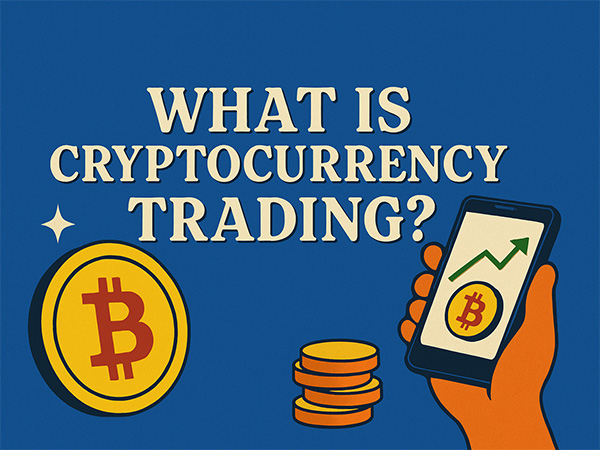The Complete Guide for Beginners to Cryptocurrency Trading in 2025: From Account Opening to Safe Trading

Cryptocurrency refers to decentralized digital assets based on blockchain technology, such as Bitcoin (BTC), Ethereum (ETH), etc. They are not issued by central banks but rely on cryptographic algorithms to ensure transaction security and ownership. Cryptocurrency trading is the act of buying and selling these digital assets through exchanges or decentralized platforms, with the goal of profiting from price fluctuations.
What Is Cryptocurrency?
Cryptocurrency is a decentralized digital currency system built on blockchain technology. Its core features include:
-
Cryptographic Security: Uses asymmetric encryption (public/private keys) to verify transaction ownership, ensuring that assets are tamper-proof and cannot be counterfeited. For example, Bitcoin uses the SHA-256 algorithm, while Ethereum uses Keccak-256.
-
Distributed Ledger Technology: Transaction data is stored and validated by global nodes (e.g., the Bitcoin network has over 15,000 nodes), eliminating the need for centralized intermediaries like banks.
-
Scarcity and Issuance Mechanism: The total supply is capped by code (e.g., Bitcoin at 21 million), and new issuance is controlled by consensus mechanisms such as Proof of Work (PoW) or Proof of Stake (PoS).
Typical Use Cases
-
Payment: Bitcoin (BTC) is used as "digital gold" for value storage and cross-border transfers.
-
Platform Utility: Ethereum (ETH) supports smart contracts that power DeFi, NFTs, and other applications.
-
Stablecoins: USDT, USDC are pegged to fiat currencies to reduce trading volatility.
Key Insight: Cryptocurrency is not virtual game money. It holds real economic value, verifiable ownership, and is globally transferable.
What Is Cryptocurrency Trading?
Cryptocurrency trading refers to the act of buying and selling digital assets via exchanges or decentralized platforms. The essence of trading is to profit from price differences. The framework includes:
Four Key Elements of Trading
| Element | Description | Example |
|---|---|---|
| Trading Venue | Centralized Exchanges (CEX) like Binance/OKX; Decentralized Exchanges (DEX) like Uniswap | Buying BTC with USDT on Binance |
| Trading Pair | Asset pair combinations (Base/Quote Currency) | ETH/USDT means buying or selling Ethereum with USDT |
| Order Type | Market Order (instant), Limit Order (specific price), Stop Order (risk control trigger) | Set a limit order to buy BTC at $38,000 |
| Settlement | Confirmed on blockchain (Bitcoin: ~10 min/tx; Ethereum: ~15 sec/tx) | Ethereum trades require 12 block confirmations |
Key Differences from Traditional Finance Trading
-
No Physical Delivery: Assets exist as balances tied to cryptographic addresses, not as paper securities or fiat bills.
-
Global Liquidity: A user in Tokyo can instantly buy Bitcoin sold by a miner in Africa.
-
24/7 Market: Operates non-stop, year-round, with real-time price movements — even during holidays.
Example: When you buy 0.01 BTC with 500 USDT on an exchange:
① USDT is deducted from your account;
② The exchange order book matches your order with a seller’s quote;
③ Blockchain records the BTC ownership transfer to your address.
Cryptocurrency Trading vs. Cryptocurrency Investing: What’s the Difference?
-
Trading: Focuses on short-term market fluctuations, aiming to profit from frequent buying and selling (e.g., intraday or swing trading), with holding periods from minutes to weeks.
-
Investing: Focuses on long-term value growth, based on project fundamentals (technology, team, ecosystem), with asset holding durations of months or even years. A typical strategy is “buy and hold” (HODL).
Key Distinction: Traders rely on technical analysis and market sentiment, while investors emphasize long-term trends and intrinsic value.
How to Trade Cryptocurrency
Here are the core steps:
-
Choose a Trading Platform
Register on a regulated exchange (e.g., OKX, Binance), complete identity verification (KYC), and ensure the platform supports fiat deposit (USD, EUR, etc.) and desired trading pairs (e.g., BTC/USDT). -
Deposit Funds
Deposit fiat via bank transfer, credit card, or third-party payment services, or transfer crypto you already hold as trading capital. -
Execute Buy/Sell Orders
-
Market Order: Executes immediately at the best available price, ideal for quick entry/exit.
-
Limit Order: Sets a target price for buy/sell; executes only when market hits the price, allowing cost control.
-
-
Manage Asset Security
After trading, transfer assets to a hardware wallet (e.g., Ledger) or non-custodial wallet (e.g., MetaMask) to reduce risk of exchange hacks.
Types of Cryptocurrency Trading
Based on strategies and tools, crypto trading can be categorized into:
-
Spot Trading: Directly buying/selling cryptocurrencies at current market prices with immediate settlement — ideal for beginners.
Example: Buy ETH worth 1,000 USDT, funds are credited instantly. -
Margin Trading: Borrow funds from the exchange to amplify positions (e.g., 5x leverage), increasing both potential profits and losses — requires strict risk control.
-
Futures Trading: Agree to buy/sell assets at a specific price on a future date; allows long (bullish) or short (bearish) positions — suitable for hedging or arbitrage.
-
Decentralized Exchange (DEX): Trade directly from wallet via platforms like Uniswap, without intermediaries — but may face limited liquidity.
What Are the Benefits of Cryptocurrency Trading?
-
24/7 Global Market: Unlike traditional stock markets, crypto never sleeps — trades respond instantly to global news.
-
High Volatility Opportunities: Large price swings offer short-term arbitrage potential; single-day moves of 10%+ are common.
-
Global Accessibility: Anyone with internet access can enter a trillion-dollar market with no geographic barrier.
-
Diverse Asset Selection: Beyond major coins, users can trade DeFi tokens, NFTs, metaverse assets, and more.
Cryptocurrency Trading vs. Stock Trading
| Dimension | Cryptocurrency Trading | Stock Trading |
|---|---|---|
| Trading Hours | 24/7 All Year | Weekdays Only, Limited Hours |
| Regulatory | Global, Fragmented Regulations | Strict Securities Laws (e.g., SEC) |
| Volatility | High, Driven by Emotion/News | Lower, Influenced by Earnings Reports |
| Asset Types | Tokens, NFTs, Derivatives | Stocks, ETFs, Bonds |
| Settlement Speed | Minutes (Blockchain Confirmations) | T+2 Days (Traditional Clearing Systems) |
What It Takes to Succeed in Cryptocurrency Trading
-
Ongoing Learning: Stay updated with blockchain upgrades (e.g., Ethereum Merge) and regulatory shifts.
-
Strict Risk Management: Limit stop-loss per trade to no more than 2% of capital; avoid reckless leverage.
-
Emotional Discipline: Resist FOMO (Fear of Missing Out); follow a strategy, not the crowd.
-
Technical Setup: Use TradingView for chart analysis, set price alerts, ensure high-speed internet connection.
Key Skills Needed for Crypto Trading
-
Technical Analysis: Recognize candlestick patterns (head-and-shoulders, triangle), apply indicators (RSI overbought/oversold, MACD trend signals).
-
Fundamental Analysis: Evaluate whitepapers, tokenomics (inflation/deflation), and on-chain metrics (e.g., active addresses).
-
Sentiment Interpretation: Use Fear & Greed Index, social media trends to anticipate short-term direction.
-
Security Practices: Enable two-factor authentication (2FA), spot phishing links, store private keys offline.
Conclusion
Cryptocurrency trading is an active investment strategy centered on buying and selling digital assets for profit. It requires mastering technical tools and risk management. Unlike long-term investing, traders face high market volatility and must continuously refine their analysis skills. Regardless of spot, leveraged, or derivative trading, success lies in disciplined execution and security awareness. Beginners are advised to start with small-amount spot trading and gain experience before exploring complex strategies.
-
Sign Up

OKX
OKX is a leading global digital asset trading platform offering spot and derivatives services for cryptocurrencies.
-
Sign Up

Binance
Binance is one of the world's largest cryptocurrency exchanges, offering spot, futures, staking, and a wide range of digital asset services.
-
Sign Up

Bybit
Bybit is a global cryptocurrency exchange specializing in derivatives, spot trading, and crypto-financial products.
-
Sign Up

Gate.io
Gate.io is a leading crypto exchange offering diverse trading options, low fees, and strong security since 2013.
